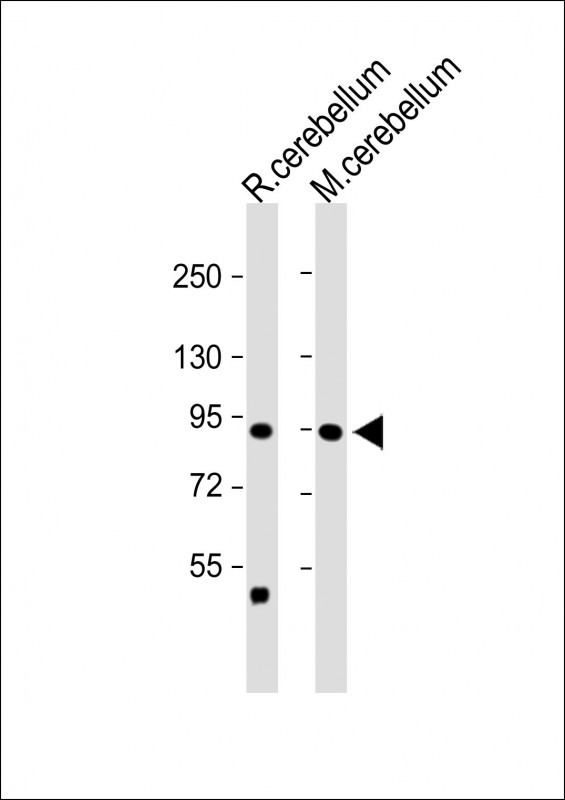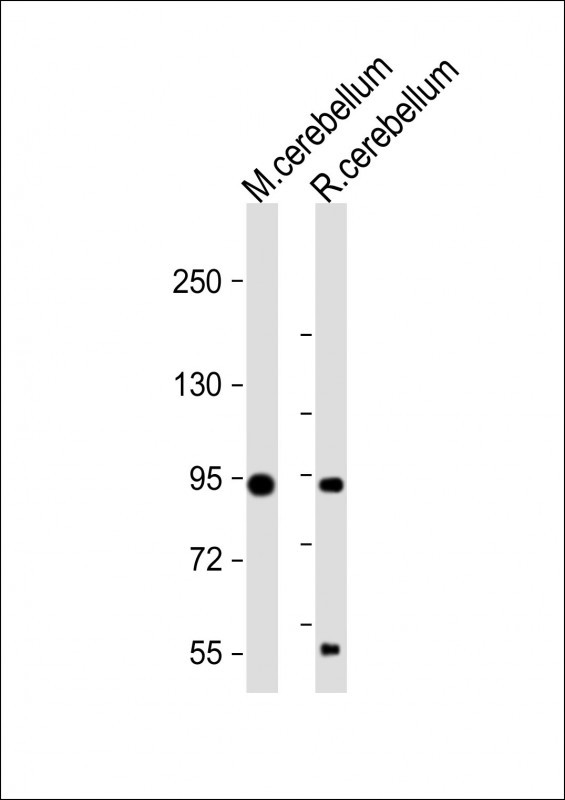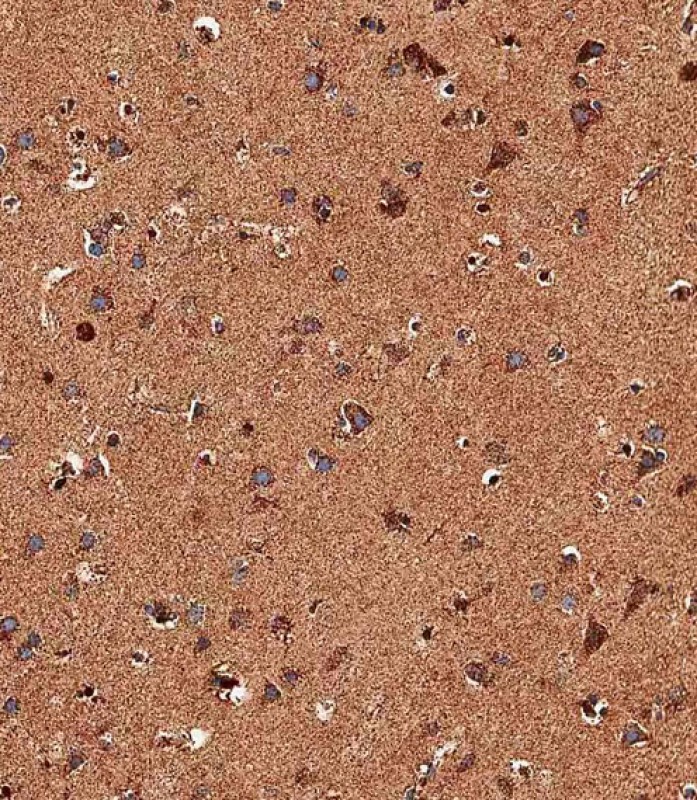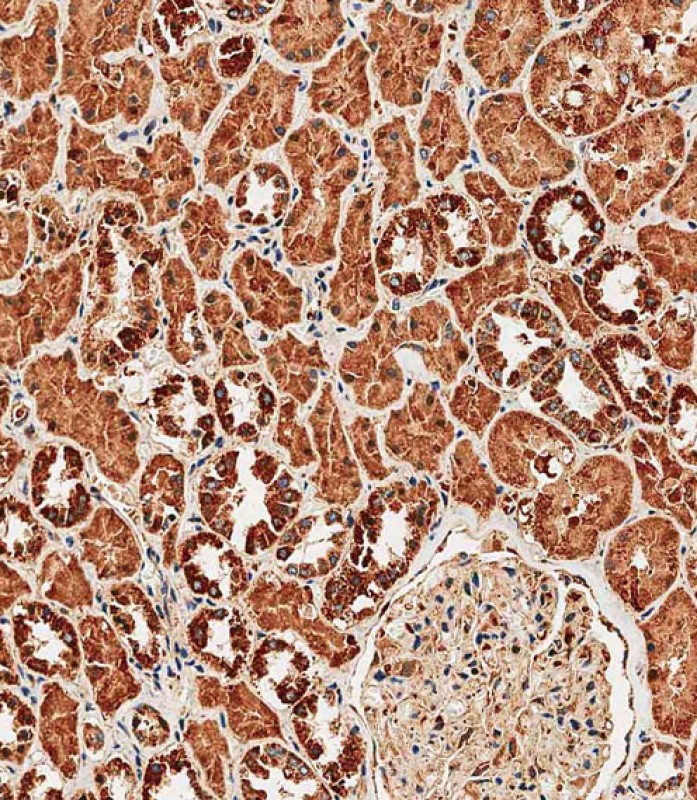TRPV1 Antibody (N-term)
Affinity Purified Rabbit Polyclonal Antibody (Pab)
- SPECIFICATION
- CITATIONS: 1
- PROTOCOLS
- BACKGROUND

Application
| IHC-P-Leica, WB, E |
|---|---|
| Primary Accession | Q8NER1 |
| Other Accession | NP_542437.2, NP_542435.2, NP_061197.4 |
| Reactivity | Human, Mouse, Rat |
| Host | Rabbit |
| Clonality | Polyclonal |
| Isotype | Rabbit IgG |
| Calculated MW | 94956 Da |
| Antigen Region | 124-153 aa |
| Gene ID | 7442 |
|---|---|
| Other Names | Transient receptor potential cation channel subfamily V member 1, TrpV1, Capsaicin receptor, Osm-9-like TRP channel 1, OTRPC1, Vanilloid receptor 1, TRPV1, VR1 |
| Target/Specificity | This TRPV1 antibody is generated from rabbits immunized with a KLH conjugated synthetic peptide between 124-153 amino acids from the N-terminal region of human TRPV1. |
| Dilution | WB~~1:1000 IHC-P-Leica~~1:500 |
| Format | Purified polyclonal antibody supplied in PBS with 0.09% (W/V) sodium azide. This antibody is purified through a protein A column, followed by peptide affinity purification. |
| Storage | Maintain refrigerated at 2-8°C for up to 2 weeks. For long term storage store at -20°C in small aliquots to prevent freeze-thaw cycles. |
| Precautions | TRPV1 Antibody (N-term) is for research use only and not for use in diagnostic or therapeutic procedures. |
| Name | TRPV1 |
|---|---|
| Synonyms | VR1 |
| Function | Ligand-activated non-selective calcium permeant cation channel involved in detection of noxious chemical and thermal stimuli. Seems to mediate proton influx and may be involved in intracellular acidosis in nociceptive neurons. Involved in mediation of inflammatory pain and hyperalgesia. Sensitized by a phosphatidylinositol second messenger system activated by receptor tyrosine kinases, which involves PKC isozymes and PCL. Activation by vanilloids, like capsaicin, and temperatures higher than 42 degrees Celsius, exhibits a time- and Ca(2+)-dependent outward rectification, followed by a long-lasting refractory state. Mild extracellular acidic pH (6.5) potentiates channel activation by noxious heat and vanilloids, whereas acidic conditions (pH <6) directly activate the channel. Can be activated by endogenous compounds, including 12-hydroperoxytetraenoic acid and bradykinin. Acts as ionotropic endocannabinoid receptor with central neuromodulatory effects. Triggers a form of long-term depression (TRPV1-LTD) mediated by the endocannabinoid anandamine in the hippocampus and nucleus accumbens by affecting AMPA receptors endocytosis. |
| Cellular Location | Postsynaptic cell membrane {ECO:0000250|UniProtKB:O35433}; Multi-pass membrane protein {ECO:0000250|UniProtKB:O35433}. Cell projection, dendritic spine membrane {ECO:0000250|UniProtKB:O35433}; Multi-pass membrane protein {ECO:0000250|UniProtKB:O35433}. Cell membrane; Multi-pass membrane protein {ECO:0000250|UniProtKB:O35433}. Note=Mostly, but not exclusively expressed in postsynaptic dendritic spines {ECO:0000250|UniProtKB:O35433} |
| Tissue Location | Widely expressed at low levels. Expression is elevated in dorsal root ganglia. In skin, expressed in cutaneous sensory nerve fibers, mast cells, epidermal keratinocytes, dermal blood vessels, the inner root sheet and the infundibulum of hair follicles, differentiated sebocytes, sweat gland ducts, and the secretory portion of eccrine sweat glands (at protein level) |

Provided below are standard protocols that you may find useful for product applications.
Background
Capsaicin, the main pungent ingredient in hot chili peppers, elicits a sensation of burning pain by selectively activating sensory neurons that convey information about noxious stimuli to the central nervous system. The protein encoded by this gene is a receptor for capsaicin and is a non-selective cation channel that is structurally related to members of the TRP family of ion channels. This receptor is also activated by increases in temperature in the noxious range, suggesting that it functions as a transducer of painful thermal stimuli in vivo. Four transcript variants encoding the same protein, but with different 5' UTR sequence, have been described for this gene.
References
Bailey, S.D., et al. Diabetes Care 33(10):2250-2253(2010)
Cantero-Recasens, G., et al. J. Biol. Chem. 285(36):27532-27535(2010)
Shieh, K.R., et al. Neurogastroenterol. Motil. 22(9):971-977(2010)
Cheng, L.E., et al. Neuron 67(3):373-380(2010)
Westlund, K.N., et al. Mol Pain 6, 46 (2010) :
If you have used an Abcepta product and would like to share how it has performed, please click on the "Submit Review" button and provide the requested information. Our staff will examine and post your review and contact you if needed.
If you have any additional inquiries please email technical services at tech@abcepta.com.














 Foundational characteristics of cancer include proliferation, angiogenesis, migration, evasion of apoptosis, and cellular immortality. Find key markers for these cellular processes and antibodies to detect them.
Foundational characteristics of cancer include proliferation, angiogenesis, migration, evasion of apoptosis, and cellular immortality. Find key markers for these cellular processes and antibodies to detect them. The SUMOplot™ Analysis Program predicts and scores sumoylation sites in your protein. SUMOylation is a post-translational modification involved in various cellular processes, such as nuclear-cytosolic transport, transcriptional regulation, apoptosis, protein stability, response to stress, and progression through the cell cycle.
The SUMOplot™ Analysis Program predicts and scores sumoylation sites in your protein. SUMOylation is a post-translational modification involved in various cellular processes, such as nuclear-cytosolic transport, transcriptional regulation, apoptosis, protein stability, response to stress, and progression through the cell cycle. The Autophagy Receptor Motif Plotter predicts and scores autophagy receptor binding sites in your protein. Identifying proteins connected to this pathway is critical to understanding the role of autophagy in physiological as well as pathological processes such as development, differentiation, neurodegenerative diseases, stress, infection, and cancer.
The Autophagy Receptor Motif Plotter predicts and scores autophagy receptor binding sites in your protein. Identifying proteins connected to this pathway is critical to understanding the role of autophagy in physiological as well as pathological processes such as development, differentiation, neurodegenerative diseases, stress, infection, and cancer.




